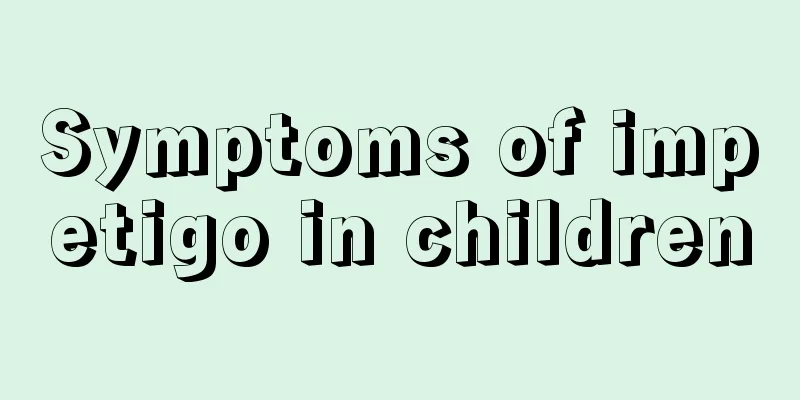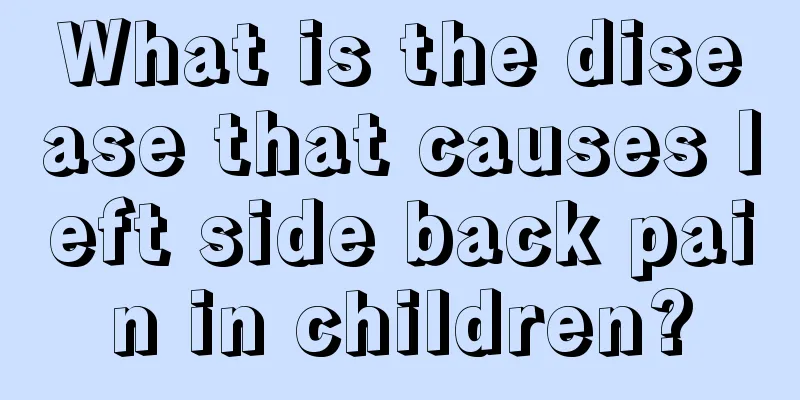Two months old baby has bloodshot eyes

|
The phenomenon of bloodshot eyes in babies is usually related to rubbing their eyes with their hands, but this symptom does not last long and will gradually subside. However, if the child has bloodshot eyes in both eyes, we need to consider the possibility of illness. The most likely factor is conjunctivitis. Because the child is young, we need to find out the situation as soon as possible so that it can be better treated. Let's take a look at conjunctivitis. Causes The causes of conjunctivitis can be divided into two categories: infectious and non-infectious according to their different natures. ① Infectious conjunctivitis caused by infection with pathogenic microorganisms. ② Allergic inflammation caused by non-infectious local or systemic allergic reactions is the most common. External physical and chemical factors, such as light and various chemicals, can also become pathogenic factors. Clinical manifestations Conjunctival congestion and increased secretions are common characteristics of various conjunctivitis. The inflammation can occur in one eye or both eyes simultaneously/sequentially. 1. Symptoms The affected eye may experience a foreign body sensation, burning sensation, heavy eyelids, and increased secretions. When the lesion involves the cornea, photophobia, tearing, and varying degrees of vision loss may occur. 2. Physical signs The signs of conjunctivitis are an important basis for the correct diagnosis of various conjunctivitis. (1) Conjunctival congestion The characteristic of conjunctival vascular congestion is that the closer to the dome, the more obvious the congestion. The blood vessels are distributed in a reticular manner, bright red in color, and can extend into the periphery of the cornea to form corneal pannus. (2) Purulent discharge is common in gonococcal conjunctivitis; mucopurulent or catarrhal discharge is common in bacterial or chlamydial conjunctivitis, and often adheres firmly to the eyelashes, making it difficult to open the eyelids in the morning; watery discharge is usually seen in viral conjunctivitis. (3) Conjunctival edema. Conjunctival inflammation causes conjunctival blood vessel dilation and exudation, leading to tissue edema. Because the bulbar conjunctiva and fornix conjunctiva tissues are loose, they bulge out significantly when edematous. (4) Subconjunctival hemorrhage is mostly in the form of dots or small patches. Epidemic hemorrhagic conjunctivitis caused by viruses is often accompanied by subconjunctival hemorrhage. (5) The papilla is a nonspecific sign of conjunctival inflammation and can be located on the palpebral conjunctiva or corneal limbus. It presents as a raised polygonal mosaic appearance with areas of hyperemia separated by pale grooves. (6) Follicles Follicles are yellow-white, smooth, round protrusions with a diameter of 0.5 to 2.0 mm. However, in some cases, such as chlamydial conjunctivitis, larger follicles may also appear. Viral conjunctivitis and chlamydial conjunctivitis are often accompanied by obvious follicle formation and are called acute follicular conjunctivitis or chronic follicular conjunctivitis. (7) Membrane and pseudomembrane Membrane is a cellulose exudate attached to the surface of the conjunctiva. Pseudomembrane is easy to peel off, while true membrane is not easy to separate. After forced peeling, the wound will bleed. The essential difference between the two lies in the difference in the degree of inflammatory response. The inflammatory response of true membrane is more severe. Corynebacterium diphtheriae causes severe membranous conjunctivitis; β-hemolytic streptococci, Klebsiella pneumoniae, gonococci, adenovirus, inclusion bodies, etc. can all cause membranous or pseudomembranous conjunctivitis. (8) Damage to scar matrix tissue is the histological basis of conjunctival scar formation. Early manifestations of conjunctival scarring include narrowing of the conjunctival fornix and subepithelial fibrosis of the conjunctiva. (9) Swollen preauricular lymph nodes Viral conjunctivitis is often accompanied by swollen preauricular lymph nodes. (10) Pseudoptosis is caused by hypertrophy of the upper eyelid tissue due to cell infiltration or scar formation, resulting in mild ptosis, which is more common in the late stage of trachoma. (11) Conjunctival granuloma is less common and can be seen in chronic inflammation caused by tuberculosis, leprosy, syphilis and rickettsia. |
<<: Children with delayed neurodevelopment
>>: What is the cause of the red bloodshot eyes?
Recommend
What complementary foods are there for babies aged five or six months?
Some people say that it is cruel for a mother to ...
What should I do if my baby is frightened and has a fever?
There are many reasons that cause babies to have ...
What is the definition of premature babies?
We all know that women have to go through ten mon...
What are the exercises that promote the growth of teenagers?
The healthy growth of young people is one of the ...
How long after a child has a rash can he or she get vaccinated?
Our country attaches great importance to the heal...
What causes baby's red and swollen eyelids?
Red and swollen eyelids are an eye disease. They ...
Six-year-old child has a hole in his big tooth
If a six-year-old child has holes on his molars, ...
What should I do if a 12-year-old child has stomach pain?
As people's quality of life improves, their d...
Why don’t children sleep? Parents need to pay close attention
Sleeping is particularly important for children. ...
What is the cause of the red spots on the child's feet?
After a child is born, the little feet are very t...
What to do if a child has appendicitis?
Some parents hear their children complain of stom...
What are the symptoms of calcium deficiency in children?
Nowadays, many families have only one child, so t...
What is the reason for children's chicken breast
Pigeon chest in children is a very common disease...
Causes and solutions for severe coughing in babies
Some babies are prone to coughing, especially at ...
9 tips to raise smart kids
All parents want their children to be smarter. Wh...









